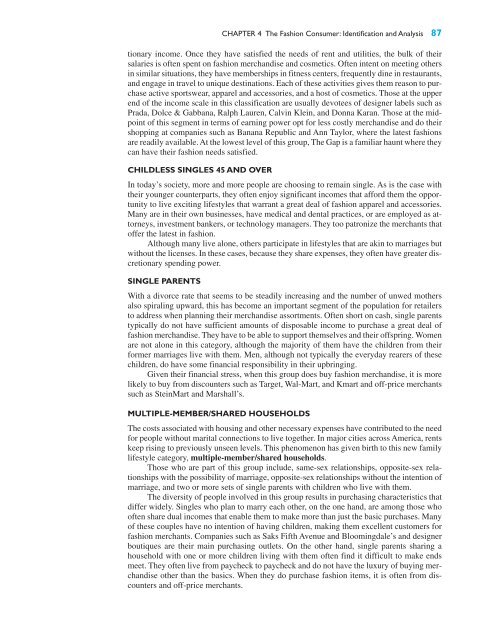Chapter 4 - Pearson
Chapter 4 - Pearson
Chapter 4 - Pearson
Create successful ePaper yourself
Turn your PDF publications into a flip-book with our unique Google optimized e-Paper software.
dia76827_ch04.qxd 11/29/04 7:55 PM Page 87<br />
CHAPTER 4 The Fashion Consumer: Identification and Analysis 87<br />
tionary income. Once they have satisfied the needs of rent and utilities, the bulk of their<br />
salaries is often spent on fashion merchandise and cosmetics. Often intent on meeting others<br />
in similar situations, they have memberships in fitness centers, frequently dine in restaurants,<br />
and engage in travel to unique destinations. Each of these activities gives them reason to purchase<br />
active sportswear, apparel and accessories, and a host of cosmetics. Those at the upper<br />
end of the income scale in this classification are usually devotees of designer labels such as<br />
Prada, Dolce & Gabbana, Ralph Lauren, Calvin Klein, and Donna Karan. Those at the midpoint<br />
of this segment in terms of earning power opt for less costly merchandise and do their<br />
shopping at companies such as Banana Republic and Ann Taylor, where the latest fashions<br />
are readily available. At the lowest level of this group, The Gap is a familiar haunt where they<br />
can have their fashion needs satisfied.<br />
CHILDLESS SINGLES 45 AND OVER<br />
In today’s society, more and more people are choosing to remain single. As is the case with<br />
their younger counterparts, they often enjoy significant incomes that afford them the opportunity<br />
to live exciting lifestyles that warrant a great deal of fashion apparel and accessories.<br />
Many are in their own businesses, have medical and dental practices, or are employed as attorneys,<br />
investment bankers, or technology managers. They too patronize the merchants that<br />
offer the latest in fashion.<br />
Although many live alone, others participate in lifestyles that are akin to marriages but<br />
without the licenses. In these cases, because they share expenses, they often have greater discretionary<br />
spending power.<br />
SINGLE PARENTS<br />
With a divorce rate that seems to be steadily increasing and the number of unwed mothers<br />
also spiraling upward, this has become an important segment of the population for retailers<br />
to address when planning their merchandise assortments. Often short on cash, single parents<br />
typically do not have sufficient amounts of disposable income to purchase a great deal of<br />
fashion merchandise. They have to be able to support themselves and their offspring. Women<br />
are not alone in this category, although the majority of them have the children from their<br />
former marriages live with them. Men, although not typically the everyday rearers of these<br />
children, do have some financial responsibility in their upbringing.<br />
Given their financial stress, when this group does buy fashion merchandise, it is more<br />
likely to buy from discounters such as Target, Wal-Mart, and Kmart and off-price merchants<br />
such as SteinMart and Marshall’s.<br />
MULTIPLE-MEMBER/SHARED HOUSEHOLDS<br />
The costs associated with housing and other necessary expenses have contributed to the need<br />
for people without marital connections to live together. In major cities across America, rents<br />
keep rising to previously unseen levels. This phenomenon has given birth to this new family<br />
lifestyle category, multiple-member/shared households.<br />
Those who are part of this group include, same-sex relationships, opposite-sex relationships<br />
with the possibility of marriage, opposite-sex relationships without the intention of<br />
marriage, and two or more sets of single parents with children who live with them.<br />
The diversity of people involved in this group results in purchasing characteristics that<br />
differ widely. Singles who plan to marry each other, on the one hand, are among those who<br />
often share dual incomes that enable them to make more than just the basic purchases. Many<br />
of these couples have no intention of having children, making them excellent customers for<br />
fashion merchants. Companies such as Saks Fifth Avenue and Bloomingdale’s and designer<br />
boutiques are their main purchasing outlets. On the other hand, single parents sharing a<br />
household with one or more children living with them often find it difficult to make ends<br />
meet. They often live from paycheck to paycheck and do not have the luxury of buying merchandise<br />
other than the basics. When they do purchase fashion items, it is often from discounters<br />
and off-price merchants.
















